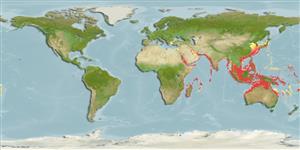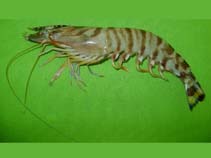Penaeus semisulcatus de Haan, 1844
Green tiger prawn| Native range | All suitable habitat | Point map | Year 2050 |

|
| This map was computer-generated and has not yet been reviewed. |
| Penaeus semisulcatus AquaMaps Data sources: GBIF OBIS |
Classification / Names Common names | Synonyms | CoL | ITIS | WoRMS
Malacostraca | Decapoda | Penaeidae
Environment: milieu / climate zone / depth range / distribution range Ecology
Benthic; brackish; depth range 2 - 300 m (Ref. 8), usually ? - 60 m (Ref. 10). Tropical, preferred 27°C (Ref. 107945)
Distribution Countries | FAO areas | Ecosystems | Occurrences | Introductions
Indo-West Pacific and the Mediterranean.
Length at first maturity / Size / Weight / Age
Maturity: Lm 10.4, range 2 - 2.4 cm Max length : 21.5 cm TL male/unsexed; (Ref. 119750); 26 cm TL (female); max. published weight: 130.00 g (Ref. 374)
Short description Morphology
Carapace and abdomen uniformly glabrous. More or less straight rostrum armed with 7 or 8 dorsal and 3 ventral teeth. Inclined downward and anteriorly hepatic carina. White and red transverse stripes present as bands in the antennae. Adrostral carina reaching well beyond epigastric tooth.
Maximum depth from Ref. 801. Occurs on mud, sandy-mud or sandy-grit substrates (Ref. 10), seagrass, mangrove and among shells (Ref. 121467). Prefers marine (adults) and estuarine (juveniles) environments in subtropical and tropical climates (Ref. 8). Forms small shoals. Predominantly nocturnal and buries in substrate during day time (Ref. 10). Postlarvae settle exclusively in seagrass beds (Ref. 84594); Juveniles also seek refuge in seagrass beds (Ref. 106924). Feeds on seagrass (Ref. 84594), diatoms, algae, (Ref. 104907), bivalves, gastropods, ophiuroids, crustaceans and polychaetes (Ref. 104903).
Life cycle and mating behavior Maturity | Reproduction | Spawning | Eggs | Fecundity | Larvae
Mating behavior: Precopulatory courtship ritual is common (through olfactory and tactile cues); usually indirect sperm transfer (Ref. 833).
Main reference
References | Coordinator | Collaborators
Holthuis, L.B. 1980. (Ref. 8)
IUCN Red List Status (Ref. 130435)
CITES status (Ref. 108899)
Not Evaluated
CMS (Ref. 116361)
Not Evaluated
Threat to humans
Human uses
Fisheries: commercial
FAO - Aquaculture: production; Fisheries: landings, species profile | FishSource | Sea Around Us
Tools
More information
Internet sources
BHL | BOLD Systems | CISTI | DiscoverLife | FAO(Fisheries: species profile; publication : search) | Fishipedia | GenBank (genome, nucleotide) | GloBI | Gomexsi | Google Books | Google Scholar | Google | PubMed | Tree of Life | Wikipedia (Go, Search) | Zoological Record
Estimates based on models
Preferred temperature
(Ref. 115969): 21.6 - 29.1, mean 28 (based on 2446 cells).
Resilience
(Ref. 69278):
High, minimum population doubling time less than 15 months (K=0.7-3.18; tm=1.8).
Prior r = 1.18, 95% CL = 0.78 - 1.77, Based on 1 data-limited stock assessment.
Nutrients: Calcium = 109 [35, 184] mg/100g; Iron = 1.59 [1.21, 1.97] mg/100g; Protein = 20.2 [19.2, 21.3] %; Omega3 = 0.285 [0.185, 0.386] g/100g; Selenium = 48.3 [-31.7, 128.3] μg/100g; VitaminA = 0 μg/100g; Zinc = 1.79 [1.17, 2.40] mg/100g (wet weight).



